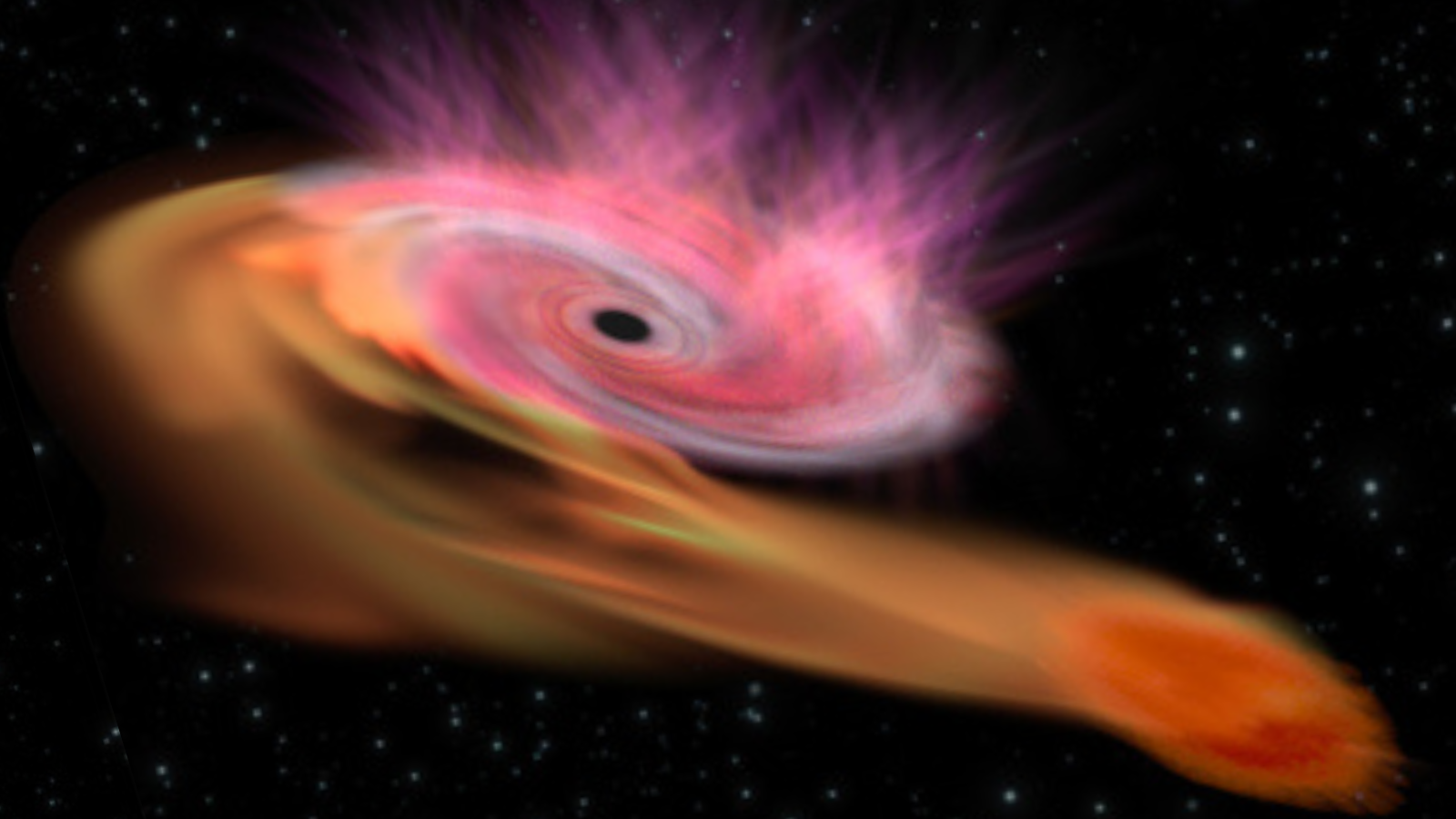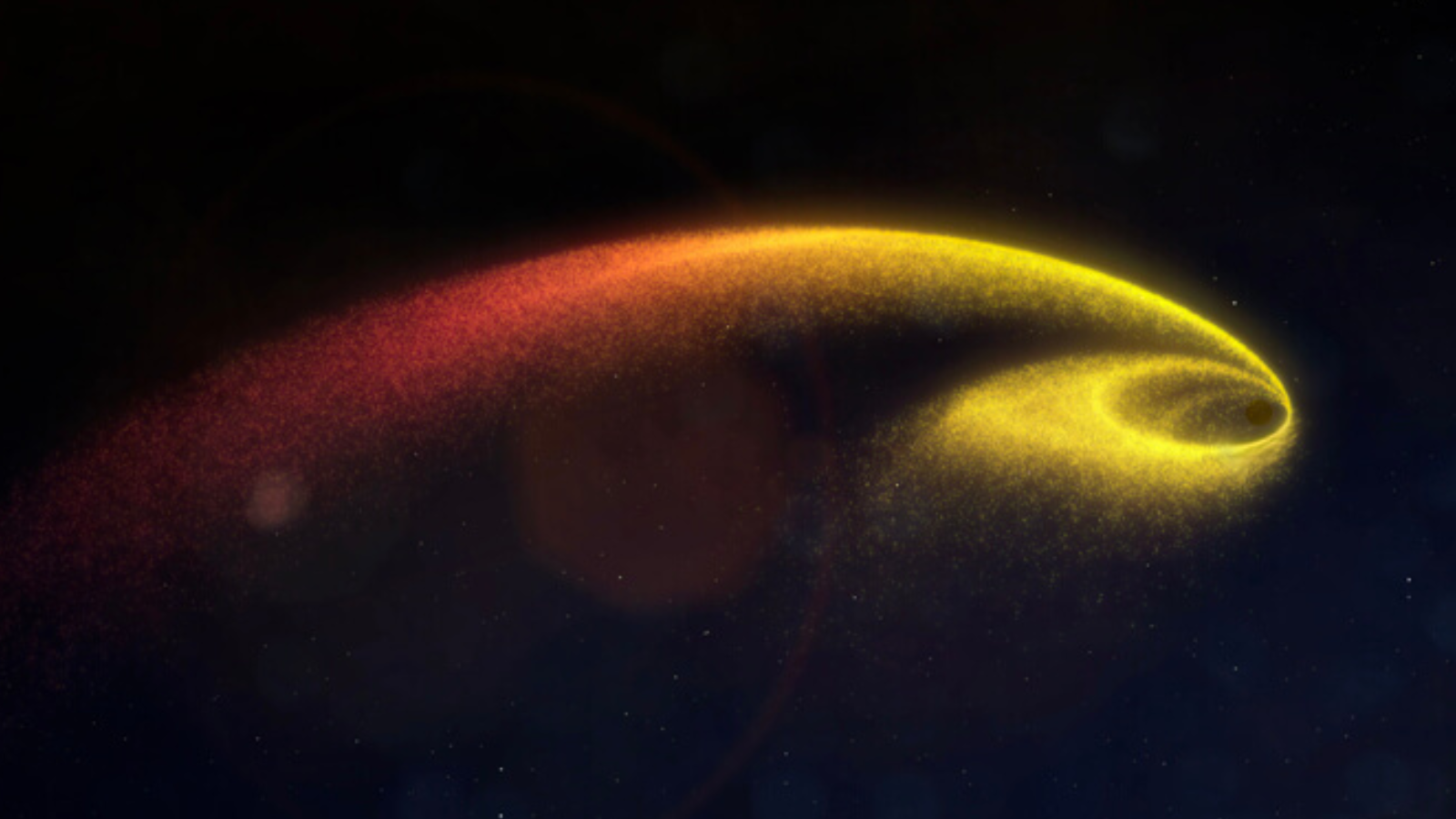
Astronomers have discovered a black hole engaged in an epic stellar meal around 9 billion light-years away from us.
The supermassive black hole, which has a mass around 10 million times that of the sun, was seen shredding a star around nine times as massive as our star and feasting on its stellar remains. This is the largest star ever seen being destroyed in one of these gory "tidal disruption events," or "TDEs."
For context, the star in this TDE (designated AT2023vto) is five times as massive as the next largest stellar body astronomers have seen a black hole destroy. As a result, AT2023vto is the biggest and brightest TDE that astronomers have ever detected.
"The thing that really sets the TDE AT2023vto apart from other TDEs is, it is incredibly, incredibly bright," team member Yvette Cendes of the University of Oregon told Space.com. "It's 9 billion light-years — and change — away. That's super far away, but it's so bright you can see it even at that distance. Typically, we see TDEs much closer to home."
Related: Black hole is 'burping out' a 'spaghettified' star it devoured years ago
This isn't the most distant TDE ever seen, to be clear.
What sets such further (and thus earlier) TDEs apart is that they blast out jets of material at near the speed of light. This makes them incredibly luminous and easier to spot at great distances. TDE AT2023vto is like the other 99% in that it doesn't have those so-called relativistic jets — at least, not yet.
"This is the furthest of this nonrelativistic category of TDEs seen thus far. That's for sure," Cendes added. "Studying this is going to be very important for learning what happens when more mass is thrown onto a black hole."
Epic mealtime
TDEs occur when an unfortunate star's trajectory brings it too close to a supermassive black hole. The immense gravitational influence of the black hole generates powerful tidal forces (hence, "tidal disruption event") within the star that simultaneously squash it horizontally while stretching it vertically.
This draws the star out into a long strand of "plasma pasta," a gory process colorfully dubbed "spaghettification."
"TDEs are interesting because they're basically a unique physical laboratory where you can test things that you can't test on Earth," Cendes explains. "After all, we can't just create black holes here on Earth and throw things on them. Studying the differences between TDEs is always going to be very exciting and interesting."
The actual TDE event lasts just a matter of hours, and the black hole devours only a small percentage of the destroyed star.
"When a TDE happens, very little of the mass of the star actually falls into the black hole proper," Cendes said. "About half the mass just gets launched on this long outward trajectory, never coming back. Around half the rest of the mass forms an accretion disk around the black hole."
As a consequence, the supermassive black holes involved in TDEs suddenly go from snacking on the occasional bit of gas or dust, and thus being very quiet, to being sat at the heart of a very chaotic, busy and bright environment that allows these cosmic titans to be seen from vast distances. Cendes pointed out that, while we can't be entirely sure about the diet of the supermassive black hole at the heart of AT2023vto, it's eating habits were certainly sparse enough that the region around it couldn't previously be seen from 9 billion light-years away.

AT2023vto was first spotted on Sept. 9 by the Zwicky Transient Facility (ZTF) as a sudden explosion of light. This transient event was initially misidentified as a Type II supernova, a cosmic blast that occurs when a massive star rapidly collapses under its own gravity.
Cendes explained that this mistake was cleared up when team leader Harsh Kumar, a researcher for the Center of Astrophysics (CfA) Harvard & Smithsonian, looked at the ZTF data. He modeled the light curve of the emission as it evolved, determining the true nature of AT2023vto, ascertaining the masses of the star and black hole involved, and figuring out the distance to this TDE.
Cendes and the team then followed up using the Very Large Telescope (VLT) to find no radio emissions associated with AT2023vto.
"We did not see anything, which may have been the less exciting result here. But that helps you rule out what this is not," Cendes said. "For example, when black holes launch relativistic jets in some TDEs which are very, very luminous, you presumably would have also seen a radio emission based off when we've seen this before, and we didn't see anything. So that kind of rules out this relativistic jet option."
Still, Cendes hasn't ruled out the possibility that this supermassive black hole could "burp" out a relativistic jet at some point, however. As Space.com reported in 2022, Cendes was part of a team that witnessed another supermassive black hole belching out powerful jets years after it had spaghettified a star. Quite how this black hole held back a cosmic burp for so long remains a mystery two years on.
Cendes thus wants to see if the black hole associated with AT2023vto is also capable of such a delayed emission.
"This is still an ongoing event; the light is still there. We're still going to keep studying this going into the future as well," Cendes said. "I'm definitely going to be looking to see if this one has a black hole burp down the line. Just because we didn't see radio emission now doesn't mean that there's no radio emission later.
"I think that's very interesting because it looks like it's a common phenomenon that I found, and nobody really has an explanation for how it works. That means there's just a lot of physics about TDEs that's still unclear to us right now."
A pre-peer-reviewed version of the team's research is published on the paper repository arXiv.







